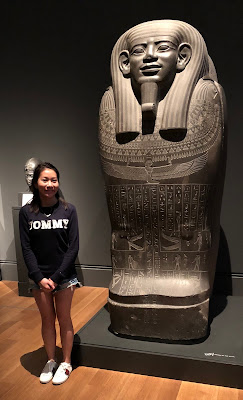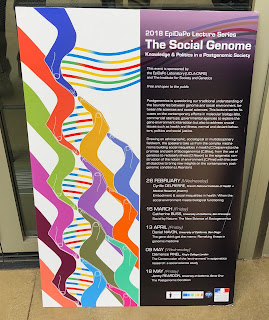Event 2: Beyond the Nile: Egypt and the Classical World
For my second event, I went to see the Beyond the Nile: Egypt and the Classical World exhibition at the Getty Center. The show displays mostly classical artifacts and sculptures, all of which are either inspired by the Greeks, Romans or Egyptians that dated all the way to the Bronze Age. In a way, I think this exhibition also demonstrates the artistic interplay between these cultures.
 |
| A Magical Text |
For centuries, historians and anthropologists have tried very hard to discover more antiquities and relics that could help shed more light on the life of the Classical World for it is crucial to learn from the past and use that knowledge to improve our society (Livy, 1998). However, there has always been a stronger emphasis on the Egyptians specifically for not only they were the oldest civilization in the world, but also for their advanced technology, architecture and medical knowledge (Vuillemot, 2015).
 |
| Mummy of Herakleides |
One of the objects that most fascinated me is the Mummy because first, it symbolizes more than just life and death. It represents the afterlife and hope. I once learned that people do not fear death itself, but instead, they fear the pain that associated with dying and the unknown that happens after death. Therefore, it is somewhat reassuring that the Egyptians saw the preservation of the corpse as a very important step to living well in the afterlife (Dunn, 2011).
Secondly, I think the Mummy could be the oldest example of the art and science intersection. It is evident that mummification is a form of art that the Egyptians had perfected long ago and the science behind the process is what enables the art to prevail until today.
The ancient Egyptians used an embalming method that allowed them to treat a dead body with preservatives to retain its resemblance to lifelike (British Museum, n.d.). This method requires detailed knowledge of human anatomy for they have to remove all organs. They then removed all moisture from the body using a particular type of salt, leaving a dried form that would not quickly decay (Smithsonian, n.d.) Then, they wrapped the body with linen, which sometimes has amulets on it as well as some drawings.
Overall, I thought that the exhibition was quite fascinating because I have always been interested in the Classical period and the exhibition help fill in some gap in my historical knowledge. However, I would not recommend this event to other students, unless they are very passionate about Egyptian history, because I think the exhibition lacks some crucial art pieces, or at least the ones I would typically expect to see in an Egyptian exhibition. I honestly expected them to at least mention something about the pyramid. Nevertheless, it was an exciting experience for me.
 |
| A Typical Features of a Priest |
Work Cited
British Museum. Mummification. n.d. Retrieved from http://www.ancientegypt.co.uk/
mummies/home.html
mummies/home.html
Dunn, Jimmy. "An Overview of Mummification in Ancient Egypt.” Tour of Egypt. 2011. Retrieved from http://www.touregypt.net/featurestories/mummification.htm
Livy. The Rise of Rome: Prologue. Translated by T.J. Luce, Oxford World’s Classic. 1998. Print.
Smithsonian Museum. Ancient Egypt: Egyptian Mummies. n.d. Retrieved from https://www.si.edu/spotlight/ancient-egypt/mummies
The Getty Center. “Beyond the Nile: Egypt and the Classical World.” 11 May 2018. Los
Angeles, CA. Retrieved from http://www.getty.edu/art/exhibitions/egypt/inner.html
Vuillemot, Tyler. “Egyptomania: Why are we so obsessed with Ancient Egypt?” Michigan State University: Department of Anthropology. 2015. Retrieved from http://anthropology.msu.edu/anp264-ss15/2015/02/11/egyptomania-why-are-we-so-obsessed-with-ancient-egypt/




Comments
Post a Comment